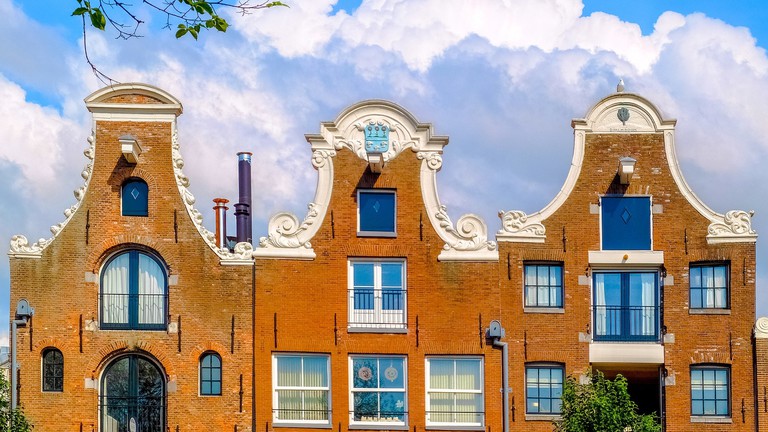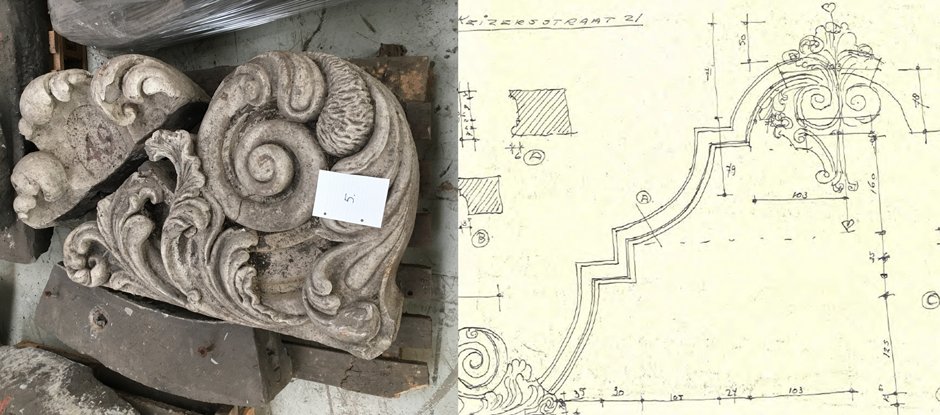
Amsterdam, the capital and main city of the Netherlands, is distinguished by its special richness and variety of architecture. Known for its canal network it is also famous for narrow houses with gabled roofs decorated with delicate details.

Typical Amsterdam houses began to appear in the XVIIth century. They were built of brick and stone, and architects had to comply with strict criteria regarding the width of the buildings. The houses were very similar to each other, and the locals were looking for ways to make their dwellings stand out.
To avoid «twinness», the owners began to decorate the facades and roofs with various ornaments and sculptures.
Thus, the pediments of the city, which originally had a simple triangular shape and repeated the line of the roof, also began to be decorated with ornaments over time.
This lead to the fashion for pediments - they began to be created in the form of garlands, steps and even “curls” that framed the houses. Now these Dutch gables are the hallmarks of the city.

Unfortunately, time did not spare these elegant architectural "wigs", and many of them began to fall apart.
To enable people to enjoy the architectural genius of the masters of that time, the Amsterdam authorities decided to take an unusual initiative - ‘Bouwfragmenten’ - now everyone can apply to the city municipality until the end of 2019 and use the old pediments and other fragments of monuments to create new architectural projects or even use them to build their own houses.
EcoTourism Expert talked with Annette ten Doeschate, project leader ‘Bouwfragmenten’ - policy advisor Monuments and Archaeology, Municipality of Amsterdam, about who can get the pieces and for what purpose they can be used.
- How did you come up with the idea to let people reuse the fragments of old buildings?
- In 1975 - 2015, approximately 100 gables were renovated and replaced onto new buildings in Amsterdam (mostly in the city center). This was a huge success but still there were tops and other fragments in the store house of the municipality. Over the past few years there was little to no attention nor plans for these objects. We wanted to bring attention of a larger public to -ultimately- get these historical ‘parts of Amsterdam’ back in the public domain.
- Can the fragments of the buildings be used exclusively for architectural purposes?
- No, the fragments can also be used as parts of an art piece or ‘transformed’ to, for example, an object for any other use. This is obviously applied to less valuable objects. We made up categories: A+ is the highest category (most valuable, in terms of heritage value) and D is the lowest category.
- Can people from other cities/countries apply to get a piece?
- Yes, but the committee will give preference to the applicants from Amsterdam. Thus, there is a higher chance of getting a fragment back in the street / public domain of Amsterdam.
- What is the most precious fragment that you offer?
- For example, the façade top from ‘t Moortje, the remains of a monument that was built for the merchant Bartolomeus Moor in 1615. This wonderful and richly decorated canal house at Herengracht, 126, in the heart of Amsterdam was brought down in 1916 and since then, the department of Monuments and Archaeology kept the fragments. But there are many more fantastic fragments - unfortunately in many cases we don’t know the exact background.
- What are the most demanded pieces?
- The smallest pieces are the most demanded, many enthusiasts from Amsterdam and other cities from the Netherlands are eager to get a small object which they can place in their front garden or onto their house.

- What will you do with the pieces that are left behind?
It's not too late. Hurry up and you may take a piece of Amsterdam to your apartment, house or garden.
